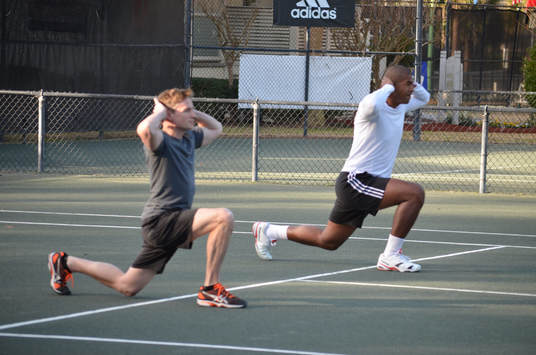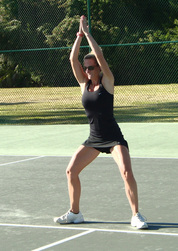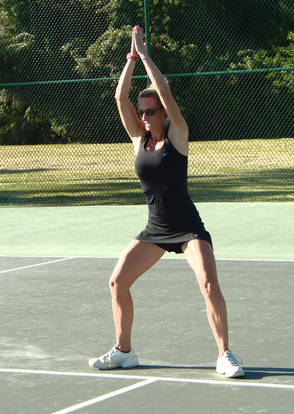Practice may be the most important part of playing tennis but recovery is just as, if not more, important in order to stay injury free. Injuries increase every year. Tennis elbow makes up for 50% of arm injuries in recreational tennis. Plantar fasciitis and knee tendonitis are other common injuries found in tennis players at both the competitive and recreational level. Technological advancement in the last 10 years has helped recreational and professional athletes increase recovery times post practice/match. As a recreational athlete you want to be able to play as much as possible and stay injury free. Below are the top 6 bang for your buck ways to decrease injuries and increase performance.
- Stretching Routine – A stretching routine can take as little as 4 minutes or as long as you want. Getting a good stretch post match or practice will not only help with muscle tightness the following day but will also increase muscle range of motion. A simple routine including 4-6 exercises completed for 30-60 seconds at a time for 1-3 rounds will help in numerous ways with muscle flexibility.
- Foam Rolling – The foam roller might be painful but your body will thank you for it afterwards. The soft tissue massage provided by the foam roller also helps improve blood flow and reduce stiffness. Research shows that foam rolling post practice or competition can help reduce the feeling of fatigue and reduce the soreness in your muscles.
- Muscle Stimulation - Are now made available to the public at an affordable price. It is commonly used to treat various issues in the recovery space. A decade ago it was common to utilize ice as a prevention treatment after training. Now using electrical muscle stimulators and other blood flow focused devices has become a more appropriate and common technique to help speed recovery. Here is some info on ways to utilize these technique on various parts of the body - http://mark-kovacs.com/marc-pro.html
- Sports Massage – A massage is probably the most commonly used recovery/relaxation technique in sports. If you have ever had a massage you know the body “feels” great once it is completed, but is it worth your time and money? Current research shows that a massage as a modality does not improve recovery or that it benefits performance. Does that mean you should not do it? Absolutely not! If you feel like getting a massage after a match or practice will help get the aches and pains out then do it.
- Recovery Boots - These techniques have become very popular over the past few years due to the portability and ease of use. The concept revolves around compression followed by relaxation around the muscles involved. The basic premise focuses on vasoconstriction followed by vasodilation of blood cells. The goal is to increase oxygenated blood to the area while moving deoxygenated blood away. Here are two companies that provide the technology and are used by athletes on a regular basis.
- Recovery Pump -https://www.rpsports.com/recoverypump
- Normatec – https://www.normatecrecovery.com/how-compression-works/how-and-science/
- NSAIDS or Nonsteroidal Anti-Inflammatory Drugs – NSAIDS are probably the most commonly used of all the above modalities. A lot of players will take some before, during, and/or after a practice or match. Research shows that in the short term there are benefits in pain reduction. The long term risk may involve increase risk of cardiovascular disease, gastrointestinal and renal problems. The short term effects of taking NSAIDS will allow you to practice discomfort free but taken over the long term on a consistent basis is not recommended. Below are a few articles of interest related to the topic of NSAIDS in athletes.
- Bring on Exercise, Hold The Painkillers https://www.nytimes.com/2017/07/05/well/move/bring-on-the-exercise-hold-the-painkillers.html
- International Olympic Committee consensus statement on pain management in elite athletes - http://bjsm.bmj.com/content/51/17/1245
All of the above mentioned modalities can help increase performance and decrease injury risk. Some have more benefits than others. It is up to you to pick which ones work best for you and combine it with your daily routine to get the most of your tennis playing experience.
Sources:
https://pdfs.semanticscholar.org/3697/9adb857bd0e925268684acd86d9d94077008.pdf
http://journals.lww.com/nsca-jscr/abstract/2014/01000/the_effects_of_myofascial_release_with_foam.8.aspx
https://www.fitmasterfreddy.com/data/blog/bloggen-mei/macdonald-2014-foam-rolling-as-a-recovery-tool-after-an-intense-bout-of-physical.pdf
http://journals.lww.com/nsca-jscr/Abstract/2009/12000/Comparison_of_Swim_Recovery_and_Muscle_Stimulation.19.aspx







 RSS Feed
RSS Feed
